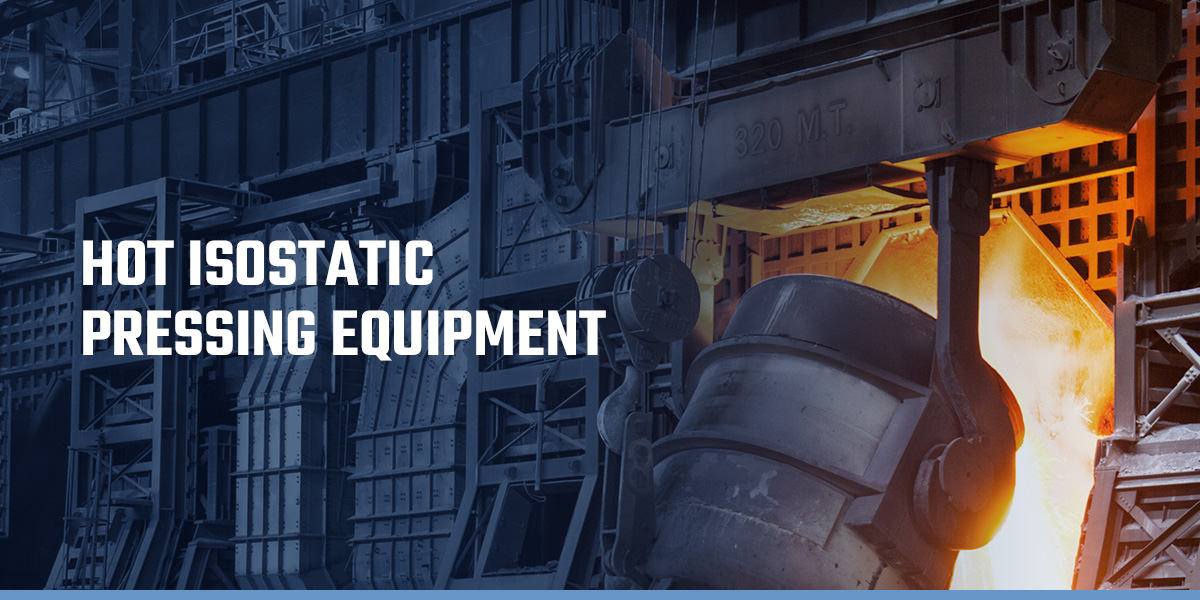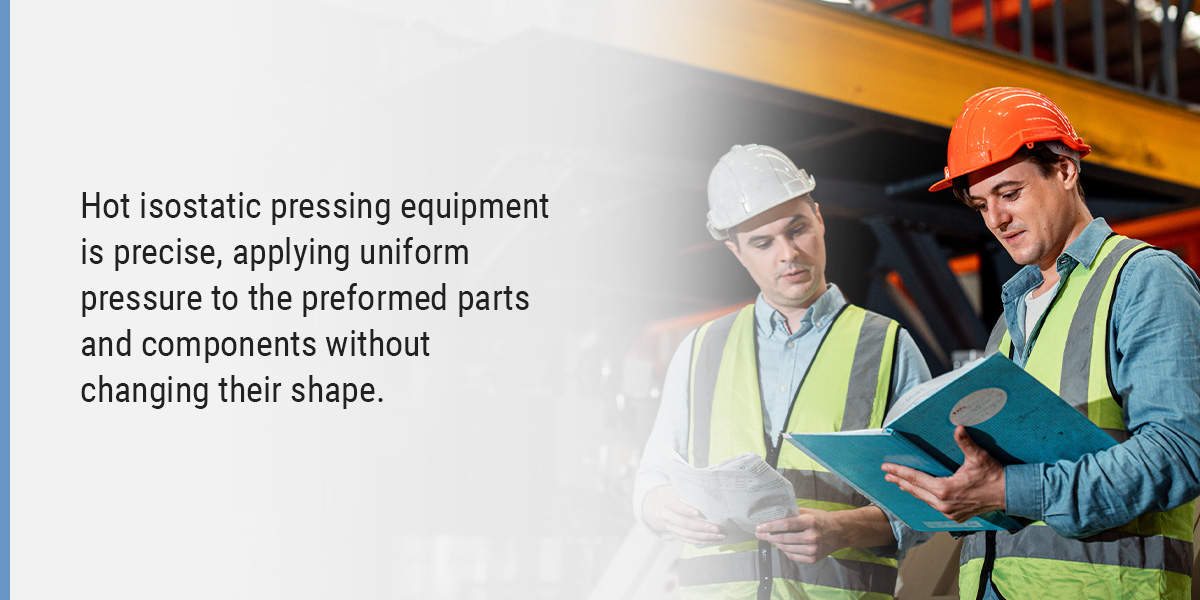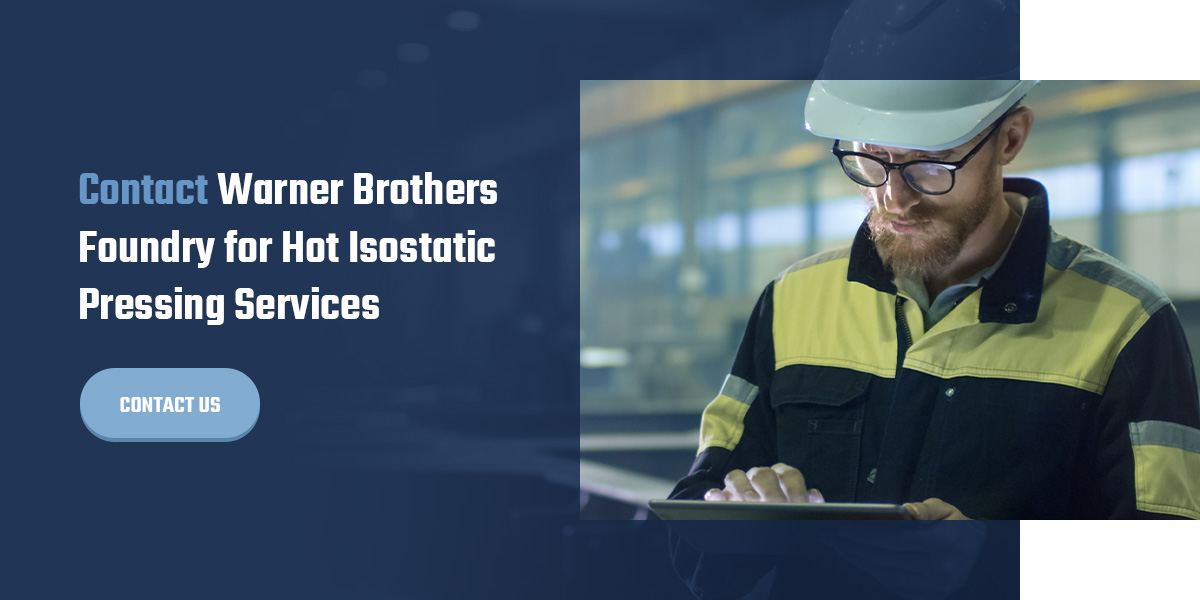Casting is a common method for producing parts and components for various industrial applications. Many industrial parts, components and tools have likely undergone hot isostatic pressing to get them to the refined state in which you recognize them. The pressure and high temperatures used in this process help solve a number of technical and mechanical problems that would otherwise be nearly impossible to correct. Hot isostatic pressing is often used on a variety of metal types, including titanium and aluminum.
If you’re looking for info about hot isostatic pressing equipment, this guide will help you learn about the process and what the advantages are.
The Hot Isostatic Pressing Process
The hot isostatic pressing process involves applying extremely high temperatures and pressure to metal parts, powder alloys and other materials. Once parts or components are loaded into the heating chamber, the chamber heats up and inert argon gas is applied. The temperature, pressure and total process time are closely monitored and precisely controlled to achieve optimal results. The hot isostatic pressing process ends with a depressurization phase and a cool-down period to ensure the parts are safe to remove from the chamber.
Metal cast parts can be inserted directly into the chamber for refinement, while the process is a bit different when used to condense powders. Powder alloys are poured to fill a casting mold, which is then welded shut. The mold then goes into the isostatic chamber and undergoes heat and pressure. At the end of the process, the powder is condensed into a solid cast object.
The hot isostatic pressing process is used on a wide range of parts and components in various applications and industries, including:
- Automotive
- Aerospace
- Military
- Heavy equipment
- Industrial machinery
- Marine
- Oil and gas
- Medical
How Does Hot Isostatic Pressing Equipment Work?
Hot isostatic pressing equipment comes in various sizes, depending on the application. For example, compact machines can be placed in labs to create small parts, while industrial-sized equipment can be used to create large industrial parts. The components you’re pressing need to be loaded into the machine’s chamber. Depending on the machine, the chamber could be loaded one of two ways — either from the top or bottom of the machine.
Once the chamber is loaded into the machine, computers take over control of the process. The computers program the hot isostatic pressing equipment to produce the desired results and the user controls the temperature ramp-up, pressure and amount of time the parts are in the machine.
All these factors depend on the part you use and what the final product needs to be. For example, the temperature may differ depending on the severity of the voids in a casting, and different processes may require a only couple of hours or need several hours at a time.
Hot isostatic pressing equipment is precise, applying uniform pressure to the preformed parts and components without changing their shape. The cylindrical chamber allows for that uniform pressure, rather than only applying the pressure from one or two sides.
Why Are Hot Isostatic Pressing Machines Used?
Industries use hot isostatic pressing machines for various purposes. These machines are versatile, which is part of the reason so many industries use them. Consider some of the uses of hot isostatic pressing machines:
- Improve mechanical properties in metals: Improving the mechanical properties of metal components helps the parts perform better in their industrial applications. In addition to the parts’ performance, their durability also improves with hot isostatic pressing. This quality enables the parts to last longer in rough conditions.
- Reduce or eliminate voids: When metal parts are cast, they often have voids or inconsistencies. These voids can make the surface uneven and the part less reliable. The hot isostatic pressing process helps work out these impurities to eliminate or, at the very least, reduce them. The high heat and pressure help perfect the metal components.
- Consolidate powders: Hot isostatic pressing machines are also great for consolidating powder alloys. This use enables operators to mold powder materials into specific parts and components with ease.
- Bond dissimilar metals: Another use of this equipment is bonding dissimilar metals and materials. When materials have different properties, bonding them can be difficult. With the hot isostatic pressing process, dissimilar materials can be bonded to create new components that are more cost-effective to manufacture.
Advantages of Using Hot Isostatic Pressing Tools
Hot isostatic pressing tools are beneficial for the industries they’re used in. Consider some of the advantages of these tools.
Completely Removes Porosities in Castings
As we mentioned before, castings can have voids. These impurities are often called porosities because the holes are minuscule, though they can have a significant impact on the quality of the metal part. The hot isostatic pressure process is beneficial because it can completely remove those porosities, resulting in a higher quality part or component.
Increases Part Resistance
As hot isostatic pressing improves the mechanical properties of materials, the part’s resistance to various elements also improves. For example, parts or components that undergo hot isostatic pressing are more resistant to heat, wear, fatigue and abrasion. This advantage is significant because the parts are then able to better withstand rough environments and applications.
Allows for More Efficient Production
Metal casting production can become a long process when parts need to be manually reworked or go through secondary machining. Hot isostatic pressing helps make the production process more efficient. By helping parts reach more precise tolerances, it can reduce or even eliminate the need for manual rework. Rather than spend time manually working out porosities, parts can reach tolerances within a few hours in the pressure chamber.
Additionally, hot isostatic pressing also helps decrease the amount of scrap material that’s lost. Without having to scrap parts with voids or waste the material from reworking them, these tools can resolve any issues.
Cost-Effective Way to Bond Metals
Bonding dissimilar metals with hot isostatic pressing is cost-effective. Normally, diffusion bonding would be a costly process when working with dissimilar materials, so this is a huge advantage. With hot isostatic pressing tools, industries can produce unique parts while saving significant money.
Contact Warner Brothers Foundry for Hot Isostatic Pressing Services
At Warner Brothers Foundry, we understand that there may be many industries or companies that may lack the space or ability to do their own hot isostatic pressing. Luckily, we have the means to help you engineer and perfect high-performance parts through hot isostatic pressing. We can help you increase your products’ durability with our efficient process and equipment. We prioritize quality and fine details to ensure your products have a higher yield.
For all your hot isostatic pressing and non-destructive testing needs, contact Warner Brothers Foundry.




